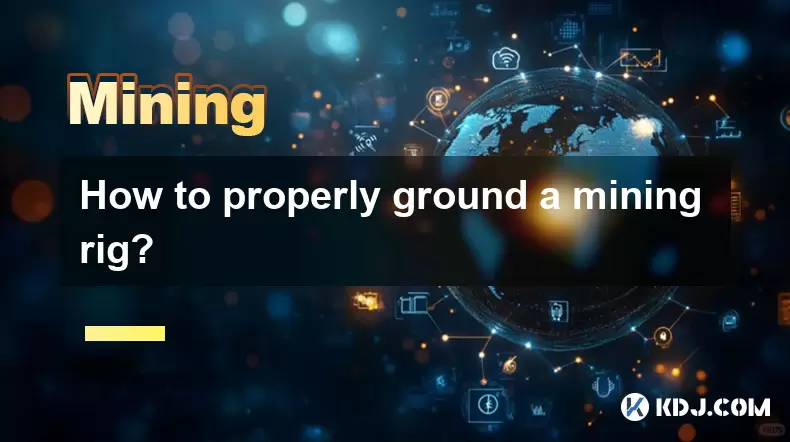-
 bitcoin
bitcoin $112715.707551 USD
-1.71% -
 ethereum
ethereum $4101.475385 USD
-3.01% -
 tether
tether $1.000644 USD
-0.02% -
 bnb
bnb $1207.619465 USD
-6.77% -
 xrp
xrp $2.501451 USD
-3.98% -
 solana
solana $202.947124 USD
-3.32% -
 usd-coin
usd-coin $1.000295 USD
0.04% -
 dogecoin
dogecoin $0.203884 USD
-4.47% -
 tron
tron $0.317154 USD
-1.72% -
 cardano
cardano $0.695009 USD
-4.43% -
 hyperliquid
hyperliquid $38.853961 USD
-8.23% -
 chainlink
chainlink $18.988674 USD
-4.64% -
 ethena-usde
ethena-usde $1.000233 USD
-0.03% -
 stellar
stellar $0.337050 USD
-3.63% -
 bitcoin-cash
bitcoin-cash $536.861728 USD
-1.28%
How to properly ground a mining rig?
Proper grounding protects your mining rig from electrical damage and ensures safe, stable operation.
Jul 18, 2025 at 08:07 am

Understanding the Importance of Grounding a Mining Rig
Proper grounding is a critical safety measure when setting up and operating a mining rig. Electrostatic discharge (ESD) can damage sensitive components, while improper grounding may lead to electrical shocks or even fire hazards. Grounding ensures that any excess electrical charge is safely directed away from your equipment, protecting both hardware and users.
Mining rigs typically operate continuously under high load, increasing the risk of overheating and electrical instability. Ensuring your rig is properly grounded helps mitigate these risks and contributes to system stability and longevity.
Selecting the Right Grounding Tools and Materials
Before starting the grounding process, gather all necessary tools and materials. You will need:
- A grounding wrist strap – This device connects you to a ground point, preventing static buildup.
- A screwdriver – For accessing the rig's internal components.
- A multimeter – To test for continuity and ensure proper grounding.
- Copper wire or grounding cable – Used to connect the rig to an earth ground.
- Metal grounding rod or existing grounding point – Such as a water pipe or dedicated electrical ground.
Ensure all tools are in good condition and appropriate for use with electronic devices. Avoid using insulated gloves when handling components, as they may trap static electricity.
Preparing the Mining Rig Environment
The location where the mining rig operates plays a significant role in grounding effectiveness. Choose a dry, well-ventilated area free from dust and moisture. Avoid placing the rig directly on carpeted floors, as carpets generate static electricity.
Place the mining rig on a non-conductive surface such as a wooden table or anti-static mat. Ensure the area has access to a grounded power outlet. Check the outlet’s grounding by using a socket tester, which confirms whether the third prong (ground) is functional.
If possible, install a dedicated circuit breaker for the mining rig to prevent overloading and ensure consistent power delivery.
Step-by-Step Grounding Procedure
- Turn off and unplug the mining rig before beginning any work. This eliminates the risk of electric shock and component damage.
- Attach the grounding wrist strap to your wrist and connect its clip to a grounded metal object, such as a radiator or grounded screw on the wall outlet.
- Open the mining rig case carefully. Touch only the edges of the motherboard or other components to avoid transferring static through your fingers.
- Locate the grounding point on the motherboard or chassis. Most cases have a designated screw hole for grounding purposes.
- Attach one end of the copper wire to this screw and secure it tightly. The other end should be connected to a metal grounding rod driven into the earth, or to a known grounded metal structure like a plumbing pipe.
- Use a multimeter to test the connection. Set it to continuity mode and check between the grounding point on the rig and the earth ground. If it beeps, the connection is solid.
- Reassemble the rig and plug it into a grounded outlet. Observe its operation for signs of instability or unusual behavior.
Repeat this process periodically to ensure continued grounding integrity.
Troubleshooting Common Grounding Issues
Even after grounding, issues may still arise. If the mining rig experiences frequent crashes, unexpected reboots, or performance drops, consider these potential problems:
- Loose grounding connections – Check all wire attachments and tighten if necessary.
- Faulty outlets – Test the outlet with a socket tester or try a different one.
- Static-prone environments – Add an anti-static spray or humidifier to reduce ambient static levels.
- Improperly grounded buildings – In older structures, the building itself may lack proper grounding. Consider installing a dedicated grounding rod outside.
Use a multimeter regularly to verify grounding continuity and identify weak points in the system.
Frequently Asked Questions
Q: Can I use a regular wire for grounding my mining rig?Yes, but ensure it's made of conductive material like copper and has low resistance. Avoid using aluminum or damaged wires for grounding purposes.
Q: Is it safe to ground a mining rig to a water pipe?As long as the pipe is metal and part of a continuous underground system, it can serve as a valid grounding point. However, confirm local electrical codes allow this method.
Q: Do all mining rigs require separate grounding rods?No, not necessarily. If your home or facility already has a strong, verified ground system, connecting to that may suffice. A separate rod offers added protection, especially in large-scale setups.
Q: How often should I test the grounding of my mining rig?It’s recommended to test every few months or after any major environmental changes, such as moving the rig or experiencing a power surge.
Disclaimer:info@kdj.com
The information provided is not trading advice. kdj.com does not assume any responsibility for any investments made based on the information provided in this article. Cryptocurrencies are highly volatile and it is highly recommended that you invest with caution after thorough research!
If you believe that the content used on this website infringes your copyright, please contact us immediately (info@kdj.com) and we will delete it promptly.
- XRP Price Prediction: Weekend Rollercoaster or Rally?
- 2025-10-12 08:45:16
- Bittensor (TAO): Super Bullish Signals Point to Potential 2x Rally
- 2025-10-11 10:25:12
- Silver Price Correction: Navigating the Dip & Identifying Key SEO Keywords
- 2025-10-11 10:25:12
- Decoding Crypto Trends: Bittensor's Bull Run, Cardano's Dip, and LivLive's Presale Buzz in 'Uptober 2025'
- 2025-10-12 08:45:16
- MoonBull: The Crypto Meme Coin Promising 1000x Gains?
- 2025-10-11 10:30:01
- Crypto Payroll Revolution: Stablecoins, Altcoins, and the Future of Salary Payments
- 2025-10-11 10:30:01
Related knowledge

Is it possible to mine crypto on a personal computer?
Oct 14,2025 at 08:18pm
Can You Mine Cryptocurrency Using a Personal Computer?1. Yes, it is technically possible to mine cryptocurrency on a personal computer. Early in the h...

The difference between staking and mining
Sep 24,2025 at 05:18am
Understanding Staking in the Cryptocurrency Ecosystem1. Staking involves holding funds in a cryptocurrency wallet to support the operations of a block...

How to participate in testnet mining?
Sep 22,2025 at 09:18am
Understanding Testnet Mining in the Crypto Ecosystem1. Testnet mining is a method used by blockchain developers to simulate real-world conditions on a...

How to dispose of abandoned mining machines?
Sep 19,2025 at 08:19pm
Assessing the Condition of Abandoned Mining Rigs1. Begin by inspecting each mining machine for visible damage, corrosion, or missing components. Machi...

How to identify high-quality mining pools?
Sep 21,2025 at 03:19pm
Reputation and Track Record1. A mining pool’s reputation is built over time through consistent performance and transparency. Pools that have operated ...

Advantages of decentralized mining pools
Sep 20,2025 at 04:36pm
Enhanced Security and Resistance to Censorship1. Decentralized mining pools operate on blockchain-based smart contracts, eliminating the need for a ce...

Is it possible to mine crypto on a personal computer?
Oct 14,2025 at 08:18pm
Can You Mine Cryptocurrency Using a Personal Computer?1. Yes, it is technically possible to mine cryptocurrency on a personal computer. Early in the h...

The difference between staking and mining
Sep 24,2025 at 05:18am
Understanding Staking in the Cryptocurrency Ecosystem1. Staking involves holding funds in a cryptocurrency wallet to support the operations of a block...

How to participate in testnet mining?
Sep 22,2025 at 09:18am
Understanding Testnet Mining in the Crypto Ecosystem1. Testnet mining is a method used by blockchain developers to simulate real-world conditions on a...

How to dispose of abandoned mining machines?
Sep 19,2025 at 08:19pm
Assessing the Condition of Abandoned Mining Rigs1. Begin by inspecting each mining machine for visible damage, corrosion, or missing components. Machi...

How to identify high-quality mining pools?
Sep 21,2025 at 03:19pm
Reputation and Track Record1. A mining pool’s reputation is built over time through consistent performance and transparency. Pools that have operated ...

Advantages of decentralized mining pools
Sep 20,2025 at 04:36pm
Enhanced Security and Resistance to Censorship1. Decentralized mining pools operate on blockchain-based smart contracts, eliminating the need for a ce...
See all articles


























![Staking ATH: How To Stake $ATH in October 2025 with 523% APY — [Step-By-Step Guide] Staking ATH: How To Stake $ATH in October 2025 with 523% APY — [Step-By-Step Guide]](/uploads/2025/10/15/cryptocurrencies-news/videos/staking-ath-stake-ath-october-apy-stepstep-guide/68eef94d80903_image_500_375.webp)















































